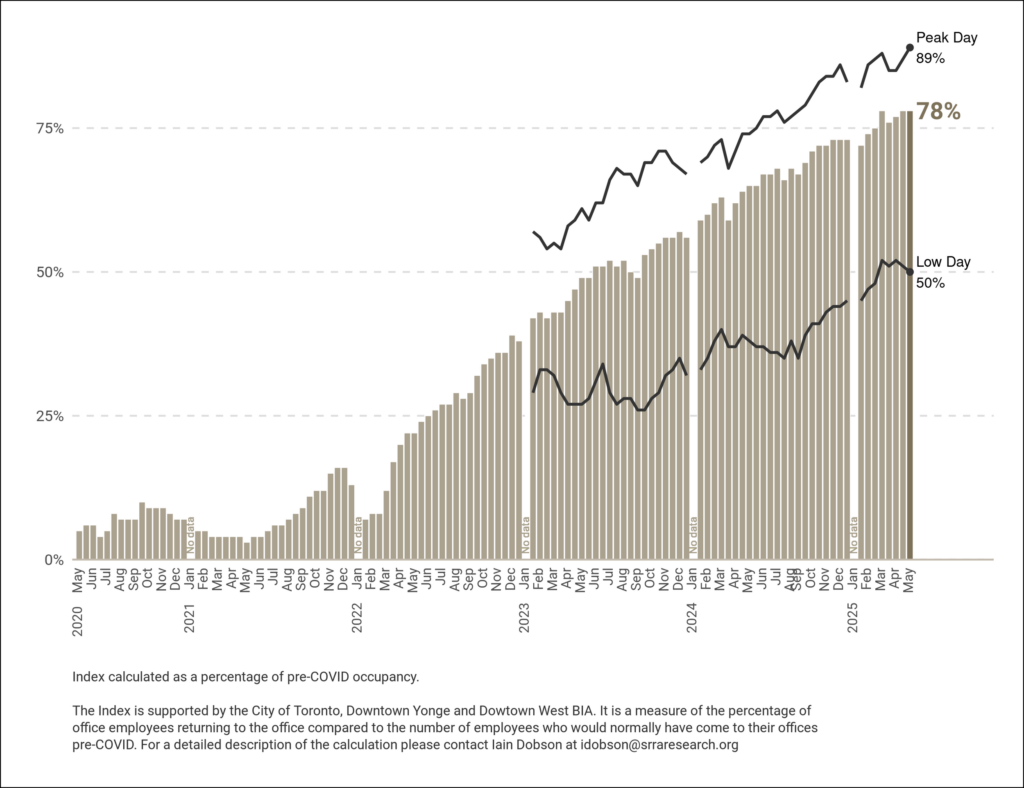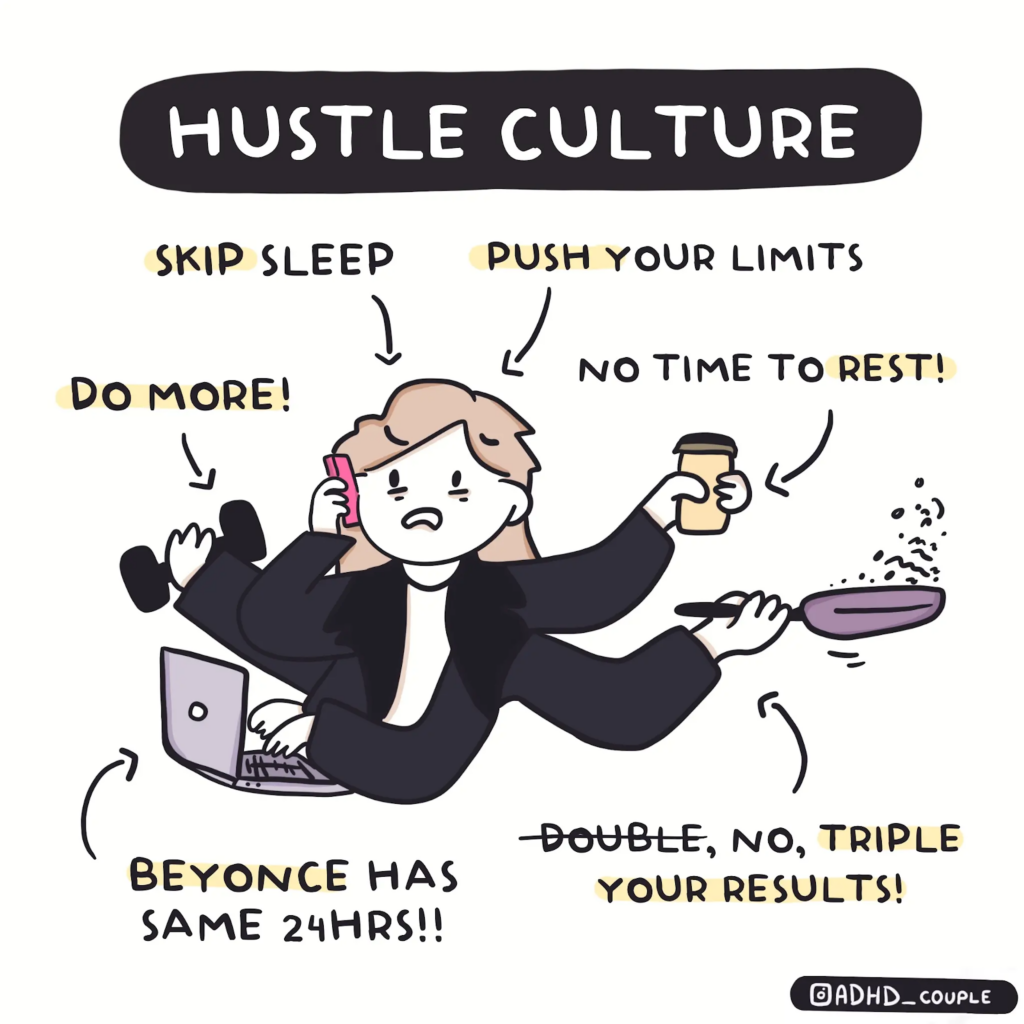There was a stretch – call it 2020 to early 2022 – when it felt like we were entering a new era of work.
People were talking about rest like it was revolutionary. CEOs were posting on LinkedIn about empathy and flexibility. “Burnout” was no longer whispered in break rooms but shouted in exit interviews.
For a moment, employees had leverage. We negotiated remote work, took mental health days without guilt, and saw job-hopping not as a red flag, but a flex. Hustle culture was publicly shamed. Work-life balance was the new north star. Employers scrambled to keep talent happy.
It was cute while it lasted.
Now? That era is quietly being erased without anyone really saying it out loud.
The job market has cooled. Budgets are tighter. And power is quietly shifting back to the people signing the checks. I’m hearing it from colleagues, clients, and friends:
- Back-to-back meetings with “optional” projects stacked on top.
- Return-to-office mandates dressed up as “collaboration culture.”
- Leaders subtly reminding people they should feel lucky to have a job.
And let’s not kid ourselves, hustle culture is absolutely making a comeback. It’s just not wearing a hoodie and posting motivational quotes anymore. Now it shows up as “high ownership,” “increased visibility,” and “tight deadlines.”
We’re watching a very real reversal happen. Employee empowerment? Cool idea. But that pendulum has swung. And if you’re not paying attention, you’re going to wake up wondering why everything feels like 2018 again… just with less free LaCroix.
So let’s talk about what’s really happening in the workplace right now, why the shift is back in full force, and what it means whether you’re running a business or trying to survive one.
The Rise and Fall of the Employee-Driven Era
For a minute there, it felt like employees were finally calling the shots.
Remote work was normalized. Mental health was a talking point in exec meetings. People were turning down jobs that didn’t offer flexibility, and companies were actually listening. It was the age of “You’re lucky to have me,” and frankly, it was kind of glorious.
And let’s not pretend it came from generosity. Employers weren’t handing out perks from the goodness of their hearts, they were bleeding talent. During the Great Resignation, people left in droves, demanding more pay, more freedom, more respect. And for a while, they got it.
Workers had leverage. Resumes with gaps weren’t taboo anymore. Four-day workweeks started trending. “Quiet quitting” became a thing. And the corporate world suddenly had to play nice.
But like all good power trips, this one didn’t last.
The job market tightened. Inflation soared. Economic forecasts got fuzzy. And right on cue, the power started shifting… again.
Companies began pulling back on remote flexibility. In 2025, 39% of employers now require full-time in-office attendance, a number that’s actually increasing, not declining (New York Post). And let’s not forget the subtle threats disguised as “collaboration culture” when you ask to work from home on a Wednesday.
Meanwhile, burnout is back like it never left. A recent study showed 66% of American workers are experiencing burnout, with the highest rates hitting 81% of 18 to 24-year-olds and 83% of 25 to 34-year-olds (Forbes). That’s not a workforce – it’s a pressure cooker.
The vibe has changed.

Where once we had boundaries, now we have badge swipes. Where once we had options, now we have performance reviews with phrases like “needs to show more initiative” aka “work later and stop complaining.”
What’s wild is that hustle culture didn’t even need a rebrand. It just waited quietly while people posted about the “soft life,” and then it slid right back into place when the economy got shaky.
And now here we are again, glorifying grind, framing 12-hour workdays as “high accountability,” and pushing employees to “lean in” to roles that keep shifting under them.
So yes, we had a moment. A powerful one. But the pendulum is swinging back. And if you’re not watching closely, it might just knock you flat.
The Market Tightens, the Power Reverses
Power in the workplace is rarely handed over, it’s taken. And when the market shifts, so does the dynamic.
Over the last year, the economic tone has changed from “there’s plenty to go around” to “tighten the belt and do more with less.” Budgets are under review. Hiring is slowing. And companies are reevaluating what’s “essential” with the same enthusiasm you bring to canceling unused subscriptions after looking at your Amex bill.
The results? Not subtle.
Return-to-office mandates are back on the table. And they’re not being presented as optional. Translation: the flexibility that was once framed as the future of work is now being revoked like a free trial that went on too long.
Performance expectations are rising too – both quietly and ever so clearly. Teams are leaner. Roles are expanding without changing titles. And employees are expected to “take ownership” of more while smiling through Slack messages that end with “let me know if you need anything.”
Meanwhile, job security is back on everyone’s mind. Layoffs are a recurring headline, not a rare shock. Inboxes are full of “organizational updates” that feel like anxiety wrapped in corporate language. And job seekers? They’re not negotiating remote-first roles anymore. They’re just trying to get offers.
Let’s be honest… when the economy tightens, so do options. And when options shrink, power shifts. That’s what we’re seeing now.
Companies are no longer wooing talent. They’re evaluating it like they’re on Shark Tank and suddenly very concerned about ROI.
All of this means we’re entering a new chapter: one where employers are holding the cards again. Not always maliciously, but definitely with more leverage than they’ve had in years.
So if it feels like the vibe shifted, it did. The landscape changed. And the unspoken agreement that “people are your greatest asset” is slowly being replaced with “people are your highest cost center.”
In the next section, we’re going to talk about the rebranding of hustle culture because even though we swore we left it behind, it’s already back. It just learned to say “fast-paced environment” instead.
The Rebranding of Hustle Culture
Hustle culture never really left. It just got better at PR.

Back in the late 2010s, hustle was glorified. Wake up at 4 a.m., grind all day, sleep when you’re dead. It was all over LinkedIn, Instagram, and your favorite bro-in-a-snapback podcast.
Then the backlash hit.
We started talking about burnout. Quiet quitting trended. People realized that glorifying exhaustion wasn’t a personality trait. Hustle became toxic. And the world promised to shift.
But here’s the truth: hustle culture didn’t die. It just changed its clothes.
Now, it’s called things like:
- “High ownership”
- “Bias for action”
- “Strong sense of urgency”
- “Fast-paced, collaborative environment”
Sounds nicer, right? Until you realize those are just rebranded expectations to stay late, do more, and ask fewer questions.
Instead of saying “work more,” managers now say “be a team player.” Instead of “always be available,” it’s “we value responsiveness.” And instead of calling it hustle, they call it culture fit.
Meanwhile, the same outcomes are happening:
- Employees are working longer hours with less clarity
- Boundaries are blurred again, especially in hybrid environments
- People are afraid to speak up because “someone else will take my place if I don’t”
And companies love to pretend this is “just how business is done.” Let’s be clear, it’s not strategy; rather, it’s survival mode dressed in brand guidelines.
The worst part? Most teams aren’t even naming it. They’re walking around exhausted, wondering why they’re burning out in a post-burnout era.
Because while the language got softer, the pressure got harder.
So if you’re a founder or leader building a company right now, this is the moment to decide which direction you’re leaning into.
Are you repeating the old system, just with better messaging? Or are you actually redefining what it means to grow a business without grinding people down?
What This Means for Founders, Leaders, and Anyone Trying to Stay Sane at Work
If you’re building a business, leading a team, or even just trying to survive in your current role, you’re not exempt from this shift. In fact, you’re in the thick of it.
For Founders and Leaders
The temptation right now is to slide back into the comfort of control. When the market tightens, the instinct is to tighten with it. More oversight. More pressure. More “can you just…” moments that snowball into full-blown resentment.
But here’s the reality: your team isn’t the same as it was in 2019. They’ve seen what freedom feels like. They’ve felt agency. They know what it’s like to work in an environment where trust isn’t earned in blood, sweat, and Slack pings at 9 p.m.
So while some companies are leaning back into pressure-based management, you have a choice.
You can build a business that extracts. Or one that sustains. One that drives performance through fear. Or one that inspires commitment through clarity.
One where people stay because they have to. Or because they actually want to.
Because here’s the truth most leaders avoid: your culture is showing up in the spaces you don’t control. In the DMs between teammates. In the unspoken energy during meetings. In the decisions your best people are making quietly, whether to stay, disengage, or leave.
For Employees
If you’re working inside a system that’s shifting out of your favor, the move isn’t panic. The move is positioning.
This is the time to build skills that are transferable. The time to clarify what kind of culture you will and won’t tolerate. The time to stop chasing ping-pong perks and start evaluating whether your company has a long-term strategy that includes you or just uses you.
Because the market may not be leaning in your favor anymore. But your leverage isn’t gone. It’s just evolving.
In a climate where people are scared to lose jobs, the smartest thing you can do is stay strategic. Play the long game. Know your worth, but back it with adaptability and real, demonstrable value.
Both founders and employees have something in common right now: we’re navigating the same storm, just from different boats.
But no matter which side of the table you sit on, the new world of work will reward those who can operate with clarity, conviction, and a refusal to go back to business-as-usual just because it’s what everyone else is doing.
The Power Is Still Within You
Let’s get one thing straight: just because the employer-employee dynamic has shifted doesn’t mean you’re powerless.
Yes, the market is tighter. Yes, some companies are pulling perks and reintroducing soul-sucking commutes under the guise of “culture.” But if all you see is limitation, that’s exactly what you’ll operate within.
The upside? It’s massive. And most people are missing it.
We are living in the most accessible era of leverage we’ve ever had.
The emergence of AI. The explosion of content creation tools. The ability to launch something on your own – a service, a product, an offer, a brand – with almost no gatekeepers and very little capital? That is not small. That is not theoretical. That is a tectonic shift.
In 2025, over 70% of Gen Z and Millennials reported interest in building their own businesses, citing autonomy, flexibility, and creative control as their top reasons (LinkedIn Workforce Insights, 2025). And they’re not just talking about it, the number of solopreneurs in the U.S. grew by 28% between 2020 and 2024, fueled by creator tools, flexible platforms, and AI-powered services (Forbes, 2025).
- You don’t need permission anymore.
- You don’t need a VC check.
- You don’t need to wait for your boss to give you a new title.
You just need a laptop, an internet connection, and the courage to build something that solves a real problem or speaks to a real interest.

And yes, here comes my back in my day moment.
Because when I was starting out, none of this existed. If you wanted to build something, it required capital, coding skills, time you didn’t have, and trial-and-error without any blueprint. You had to piece together whatever you could from Google searches and hope someone would take you seriously.
Now? You have AI tools that can help you write, design, ideate, script, and even generate entire marketing campaigns.
Today, 84% of content creators use AI in some part of their workflow, whether it’s scripting, editing, copywriting, or repurposing content across channels (HubSpot Creator Economy Report, 2025). The time to create and distribute has collapsed. Execution speed has been cut in half and in some cases, by 90%.
It’s never been easier or faster to validate and build a side hustle around what you genuinely care about.
And no, this isn’t just hype. Solopreneurship isn’t a trend. It’s a viable path. People are turning niche knowledge into real revenue. They’re using content to build trust and community. They’re using AI to extend their capacity. They’re building lean, efficient, sustainable businesses without teams or investors. And they’re doing it on their terms.
But here’s the key: they’re not waiting to be picked. They’re not asking for permission. They’re executing.
If you’re feeling stuck in a system that doesn’t serve you, let that be your signal. Not to rage quit or burn it all down, but to start building your own runway. Start small. Test fast. Show up consistently.
Because the power shift may have moved in the corporate world. But on the internet? You’ve never had more autonomy.
So if you’re going to hustle, let it be for your vision. Your ideas. Your future.
Not for someone else’s bonus structure.
You Can Stay Bitter, or You Can Build
Look, the system is flawed. No argument there. Yes, employers are regaining power. Yes, burnout is back. Yes, some of the flexibility we fought for is slipping.
But if all you do is rage about it, scroll through hot takes, and convince yourself you’re stuck, then you’re just playing into it.
That’s the real trap. Not just working under the system.
But believing it owns you.
We are not in 1998. You do not need an office, a boss’s blessing, or a resume that makes sense on paper to start building something real.
You have the tools. You have the internet. You have the ability to publish, build, sell, and scale from your damn kitchen table. That used to be science fiction. Now it’s a Tuesday.
And no, this isn’t about false hope or pretending it’s easy. It’s hard. It’s lonely. It takes grit and zero entitlement. But at least you’re playing a game you designed, not begging to be picked in one you never wanted to play.
- So stop waiting.
- Stop blaming.
- Start building.
You might not control the system. But you do control whether you get swallowed by it or outgrow it.
Make your choice.





